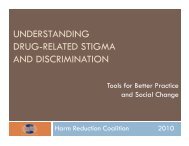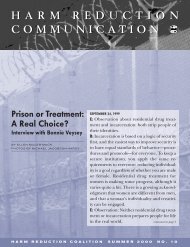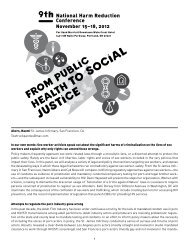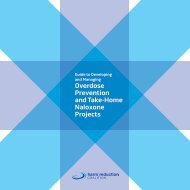Lifepoint Guidelines and Operating Procedures Manual - Harm ...
Lifepoint Guidelines and Operating Procedures Manual - Harm ...
Lifepoint Guidelines and Operating Procedures Manual - Harm ...
- No tags were found...
Create successful ePaper yourself
Turn your PDF publications into a flip-book with our unique Google optimized e-Paper software.
LIFEPOINTOutreach & SyringeExchange Program<strong>Guidelines</strong> <strong>and</strong><strong>Operating</strong> <strong>Procedures</strong>February 20051
The Program“<strong>Harm</strong> Reduction isa Process; theRelationship is theIntervention”<strong>Lifepoint</strong> is a harm reduction program that attempts to prevent the spread ofthe Human Immunodeficiency Virus <strong>and</strong> Hepatitis C Virus (HIV/HCV) amonginjection drug users <strong>and</strong> their partners. The program operates through roving<strong>and</strong> mobile sites where staff exchange used needles for clean ones. Other servicesinclude HIV counseling, HIV testing, substance abuse <strong>and</strong> disease preventioninformation, referrals to social services programs <strong>and</strong> Hepatitis C testing,<strong>and</strong> distribution of bleach, safer sex kits, <strong>and</strong> other health information.Staff also frequently work to encourage injection drug users toenter treatment. ARCW’s Dennis C. Hill Center in Milwaukeeprovides injection drug users treatment based on the harm reductionmodel.Lifpoint began in 1994 in Milwaukee as a harm reduction programof ARCW <strong>and</strong> has grown to provide services in 11 citiesthroughout ARCW’s AIDS service jurisdiction.<strong>Harm</strong> Reduction“<strong>Harm</strong> Reduction focuses on reducing the harms related to drug use ratherthan eliminating drug use itself. <strong>Harm</strong> Reduction aims to: prevent the spreadof infections including HIV/AIDS, Hepatitis <strong>and</strong> other blood-borne infections;reduce the risk of overdose <strong>and</strong> other drug-related fatalities; <strong>and</strong> lessen thenegative effects drug use may have on individuals <strong>and</strong> communities includingpoverty <strong>and</strong> crime.<strong>Harm</strong> Reduction approaches drug use from a realistic <strong>and</strong> pragmatic publichealth perspective <strong>and</strong> focus on feasible goals. Further, by preventing thespread of blood-borne infection among IDUs, <strong>Harm</strong> Reduction helps to preventthe spread of HIV/HCV among the entire population.”Adapted from the <strong>Harm</strong> Reduction Coalition’s website.Why <strong>Harm</strong> Reduction?The evidence collected worldwide, to date, about HIV/HCV harm reductionoutreach with syringe exchange shows the following:• Most injection drug users are not in treatment;• Reaching these women <strong>and</strong> men is crucial to reducing the sexual<strong>and</strong> injection risks HIV/HCV poses for them, their partners, <strong>and</strong>their children;2
Intermediate Outcome Indicators:• The type <strong>and</strong> amount of sterile injection equipment distributed;• The percentage of <strong>Lifepoint</strong> participants who demonstrates a reductionin the following HIV/HCV risk behaviors:o Sharing needleso Sharing injection equipment (water, cotton, cookers)o Using a new needle for every drug injectiono Disinfecting needles before every drug injection if no newneedles are available.o Multiple sex partnerso Unprotected sexLong-Term Outcome: IDUs complete treatment at the Dennis C. Hill <strong>Harm</strong>Reduction Center or other provider.Long-Term Outcome Indicators:• The number of participants who complete treatment• The percentage of participants who decrease / manage their druguse.Range of ServicesThe team is skilled in the areas of substance abuse assessment <strong>and</strong> referral.The encounter may be brief until a trusting relationship has been established.Some encounters may last just minutes; others may last 45 minutes or more,depending upon the receptivity <strong>and</strong> needs of the client. The Needle ExchangeProgram (NEP) is part of a comprehensive program to reduce HIV/HCVinfection among IDUs in Wisconsin. While the needle exchange program hasthe simple, straightforward mission to distribute clean needles <strong>and</strong> supplies toIDUs, the encounter is a unique opportunity to serve as a link to alcohol <strong>and</strong>drug treatment, primary health care, TB/STD services, mental healthcare,HIV/HCV programs, <strong>and</strong> other community services. Services will be providedfree of charge.5
<strong>Harm</strong> reduction outreach does the following:• Provides materials for <strong>and</strong> discussion about reducing sexual <strong>and</strong> injectionrisks of HIV/HCV infection, including safer sex <strong>and</strong> safer injection kits;• Exchanges used barrels <strong>and</strong>/or detachable needles for sterile syringes on atwo-for-one basis for the first five <strong>and</strong> on a one-for-one basis thereafter;• Provides discussion about <strong>and</strong> voluntary <strong>and</strong> anonymous referral to treatmentof alcohol <strong>and</strong> other drug use, medical care, <strong>and</strong> other risk reductionservices of a person's choosing;• Provides both voluntary <strong>and</strong> anonymous HIV <strong>and</strong> HCV testing• Accesses <strong>and</strong> builds relationships between drug users <strong>and</strong> outreach workers;<strong>and</strong>• Offers those served with an additional avenue for positive change.Link to Treatment, Link to CareIt is anticipated that <strong>Lifepoint</strong> will become a link to substance abuse treatmentfor a number of individuals who are addicted to substances. The interactionsbetween staff of ARCW’s <strong>Lifepoint</strong> program <strong>and</strong> the clients will often result inreferrals to alcohol <strong>and</strong> drug abuse treatment, HIV/HCV counseling <strong>and</strong>testing, <strong>and</strong> primary care sites. Early intervention for HIV/HCV throughcounseling <strong>and</strong> testing programs <strong>and</strong> alcohol <strong>and</strong> drug abuse treatmentprograms is the most effective way to reduce the potential for infection (orthe spread of infection). The <strong>Lifepoint</strong> intervention involves elements ofreducing HIV/HCV transmission by decreasing the number of injections thatinvolve contaminated equipment <strong>and</strong> actively linking drug injectors to HIV/HCV <strong>and</strong> drug treatment services.Accessing the publicly funded alcohol <strong>and</strong> drug treatment system can beconfusing. Available slots change on a day-to-day basis. The team will workclosely with the Intervention Specialist <strong>and</strong> their local resources in termsof referrals, placement, priority admissions, <strong>and</strong> identification of availableslots. Clients will receive referrals to the publicly funded substance abusesystem. Clients who do not wish treatment may continue to receive needles.An additional attempt to recruit them into treatment may occur at a later date.Because of the challenges that substance users face, there will be no limit asto the number of times an individual may utilize the program.The team will also work with the network of HIV/HCV <strong>and</strong> primary careproviders. They will triage <strong>and</strong> assess the needs of the client <strong>and</strong> provide aneffective link to the appropriate level of care, be it HIV anonymous orconfidential testing or primary health care services.6
“Meeting Them Where They’re At”Our sites for harm reduction outreach with syringe exchange will be selectedwith as much community input as possible. The sites will be stable. That is,once selected, with maximum community input <strong>and</strong> thought, the sites <strong>and</strong>times of our operation will remain consistent. This consistency in site <strong>and</strong> timeis essential to reaching <strong>and</strong> earning the support of injection drug users. Otheroutreach efforts have found that even moving an operation around the cornerloses as many as half of participants. In addition, because word of mouth isthe primary means of advertising, consistency facilitates accuracy of sharedmessages. Site selection with community input is extremely important becausethe costs of moving the site are so high with respect to lost users <strong>and</strong> failedconfidence.The Team <strong>and</strong> What They DoAll women <strong>and</strong> men working the needle exchange <strong>and</strong> outreach need to challengethemselves to consider the personal impact of this work. If anyone onthe exchange is not first <strong>and</strong> foremost taking good care of themselves, theywill be unlikely to care adequately for the people we reach. All women <strong>and</strong>men working the program should honestly challenge themselves to be awareof their own mental <strong>and</strong> physical health <strong>and</strong> communicate openly with theirfellow staff.Additionally, everyone working the outreach must meet or adhere to the following:• Exchange <strong>and</strong> provide outreach at all sites <strong>and</strong> process your reactionto this work with the Coordinator• Demonstrate competence in underst<strong>and</strong>ing <strong>and</strong> applying the materialwithin this "<strong>Guidelines</strong> <strong>and</strong> <strong>Operating</strong> <strong>Procedures</strong>" as evaluatedby the Coordinator of the site you primarily work.• Be able to communicate well with co-workers <strong>and</strong> adequately performall functions while working the outreach.• Have no signs or smells of intoxication.• Observe that all activity must be respectful of all community membersat all times - "We are in their house".• Meet 15 minutes prior to leaving for the first site <strong>and</strong> plan roles <strong>and</strong>immediately after the day to share feedback.• Support all other workers of the exchange while working with them.• Do not touch used syringes or needles - always ask someone topickup or otherwise touch their own syringes or needles. B<strong>and</strong>age opencuts, wash h<strong>and</strong>s after the outreach <strong>and</strong> know emergency postexposureprotocol. (See OSHA Exposure Protocols, found at the end ofthis manual)7
• Consider the utility of HBV vaccination for themselves.• Take responsibility for working out any interpersonal conflicts in orderto keep principles above personalities.• Be responsible for taking care of themselves sufficiently in order tonot negatively influence the operation of the outreach.• Have a yearly TB screening done on the employment anniversarydate.Job DescriptionsNeedle Exchange Specialist• Greets person coming to the outreach <strong>and</strong> inquires about their interests incoming. (e.g. "What can we help you with? or "Do you want to know whatwe do here?")• Listens to the individual. They know their situation best <strong>and</strong> knows whattheir needs are.• Determines if they are familiar with the options of assistance with positivechange that <strong>Lifepoint</strong> offers on the site. Informs person of options.• Directs person only interested in safer sex discussion <strong>and</strong> materials to OutreachWorker. If the Outreach worker is preoccupied or not available theNeedle Exchange Specialist will engage the individual in a safer sex discussionconcluding in the distribution of safer sex materials.• Engages persons interested in safer injection <strong>and</strong> sex discussions <strong>and</strong> offersclean needle exchange services.• Determines total number of syringe barrels <strong>and</strong>/or detachable needlesdropped into the sharps container.• Fills out exchanger data information for every exchanger.• Determines the total number of syringes to be given in return. We givetwo syringes for every one turned in for the first five in order to assist peoplework toward "one shot-one sterile syringe" <strong>and</strong> also assist others withthis goal.• Offers clean water, cottons, cookers, alcohol pads, site sheets - <strong>Lifepoint</strong>believes exchangers knows their own needs. Ask them how many they arehelping today <strong>and</strong> accommodate appropriately. Our limits are defined bythe needs for materials by subsequent exchangers.• Offers information <strong>and</strong> discussion on the use of any of the materials offeredor other means of reducing harm from injection if time allows, or• Refers interested people to appropriate <strong>Lifepoint</strong> services, including; HIV &Hepatitis C screening, Safer sex materials, AODA treatment, housing,health care, etc.• Finally, Thank them for utilizing our services <strong>and</strong> for helping others stayhealthy.8
Outreach Specialist• Respectfully engages person, informs them of the range of topics/optionsfor positive change available on-site <strong>and</strong> determines their interests in accessingany of these options.• Asks person utilizing outreach if they are interested in any safer injectionor safer sex materials or the latest information regarding safer injection<strong>and</strong>/or safer sex. The goal here is to let the person know we are capable<strong>and</strong> interested in discussing safer injection/sex in a respectful <strong>and</strong> collaborativefashion. Listens carefully for referral opportunity.• Offers clean water, cottons, cookers, alcohol pads, site sheets. Our limitsare defined by the needs for materials by subsequent injectors.• Offers lubed <strong>and</strong> unlubricated condoms <strong>and</strong> lubricant as appropriate. Ourlimits are defined by the needs for materials by subsequent sexual risk reductioncontacts.• Offers printed information <strong>and</strong> discussion on use of any of the materialsoffered or other means of reducing sexual risks of HIV/HCV infection <strong>and</strong>other STDs.• If the individual is interested in discussing their risk behaviors, encouragethem to make behavior change commitments <strong>and</strong> help them fill out aChange Commitment form. Pick a time when you can meet with the individualat a later date <strong>and</strong> follow up with their process.Needle Exchange Specialist & Outreach SpecialistThe Needle Exchange Specialist <strong>and</strong> Outreach Specialist are responsible forfollowing the schedule posted for the week. If there is some reason that theschedule cannot be followed as posted it is the responsibility of the NeedleExchange Specialist <strong>and</strong> the Outreach Specialist to contact their supervisor toobtain a revised schedule. They also share the responsibility for getting thevan to the site <strong>and</strong> bringing sufficient supplies for outreach work. The teamshould leave the office at least 15 minutes prior to start.IDU Coordinator• Recruits, schedules, <strong>and</strong> supports all other site workers. Provides feedbackto volunteers about their job performance <strong>and</strong> works to improve same ifindicated.• Facilitates assignment of jobs for outreach operation. Takes responsibilityfor assuring that each person is capable of performing the work of theirposition onsite.• Oversees flow <strong>and</strong> activity of operation.• May perform any of the jobs above as well, if appropriate.• Actively solicits feedback from people using the outreach including how9
people think the operation is working <strong>and</strong> ideas for improvement.• Reports problems with full outreach operations directly to Associate Directorof Prevention Services.ObserversThe <strong>Lifepoint</strong> intends to cooperate with public authorities <strong>and</strong> interested observers,including the press, to facilitate underst<strong>and</strong>ing of the organization<strong>and</strong> its objectives. Past experience dictates a preference for pre-planned <strong>and</strong>pre-approved contact in order to prevent people from avoiding our <strong>Lifepoint</strong>services. Cameras are best used at the very end of the outreach <strong>and</strong> with everyone'spermission.VolunteersVolunteers are crucial to the success of the <strong>Lifepoint</strong> program <strong>and</strong> have aspecific purpose in the harm reduction process.• Assist the Outreach Specialist by providing outreach services at <strong>and</strong>around the <strong>Lifepoint</strong> site.• Assist the Needle Exchange Specialist by providing assistance with exchanges:preparing supplies <strong>and</strong> materials, documenting the exchange,<strong>and</strong> engaging the consumer in risk reduction dialog.All volunteers must have completed the proper volunteer documentation,have previously been screened for TB <strong>and</strong> have had the proper OSHA<strong>and</strong> Outreach training before they are able to volunteer on site.AODA Intervention SpecialistThe Intervention Specialist is responsible for providing direct services in theMilwaukee area to persons engaging in high risk behaviors. The staff willassist outreach <strong>and</strong> needle exchange staff in facilitating outreach accessingservices such as AODA treatment, methadone, shelter, needle exchange <strong>and</strong>other services deemed necessary. The staff will also:• Conduct one-on-one educational sessions with contacts made with drugusers through street outreach.• Assess outreach contact needs <strong>and</strong> make the appropriate referrals toagencies equipped to meet the need.• Assist in transporting outreach contacts <strong>and</strong> facilitate their accessingservices.Operational <strong>Guidelines</strong>Required Pre <strong>and</strong> Post SitesAn office pre-operation meeting at least 15 minutes prior to the leaving to the10
first site will include the following:• meeting <strong>and</strong> assessment of the team;• airing any personal or professional concerns about the operation;• assignment <strong>and</strong> clarification of site jobs; <strong>and</strong>• arrangement of supplies, including fueling the vans prior to leaving.*Bring in condoms at the end of each day <strong>and</strong> needles in when the temperaturecould reach below 0 degrees Fahrenheit.A weekly feedback session in office with the IDU Coordinator willinclude the following:• Filling out the End of Day Data Sheet numbers together;• Noting any delights or difficulties of the week's operation;• Processing feedback received regarding any aspect of our operation;• Sharing personal <strong>and</strong> professional feedback among team members;• Giving all data forms to the Coordinator.• Returning all leftover supplies to the appropriate storage facilities; <strong>and</strong>• Delivering used syringes to appropriate disposal or storage site.PROCEDURES FOR SYRINGE COLLECTION AND DISPOSALSyringe Collection:Throughout all <strong>Lifepoint</strong> operations at no time are syringes to be touched. Thepeople bringing syringes in to exchange are responsible for placing them directlyinto our puncture-proof sharps container. If a syringe falls on theground or otherwise does not make it into the sharps container <strong>Lifepoint</strong> personnelwill ask the person who brought it in to place it in the sharps container.Tongs will be available to assist anyone in reducing their contacts with the syringes.Be cautious about syringes brought in plastic bags. Require the exchangerto carefully place entire bag in the biohazard container. Exchangersshould also be encouraged to bring used, rinsed syringes in a solid plastic container<strong>and</strong> dispose of the package in its entirety.When a sharps container is full to the line indicated on its side it should beclosed with the attached lid <strong>and</strong> put in a safe, out of- the-way place. It is notreopened or reused after this point <strong>and</strong> it proceeds directly to disposal (asoutlined below).These procedures are more stringent than the Blood BornePathogens St<strong>and</strong>ards as promulgated by the Occupational Safety <strong>and</strong>Health Administration (OSHA) for health care settings.Syringe Disposal:Full sharps containers are taken to its appropriate location in the ARCW building,immediately upon arriving to the office <strong>and</strong> placed inside a red, appropri-11
ately labeled plastic bag which rests inside an appropriately labeled cardboardbox. When the box is full, the plastic bag is closed over the sharps containers<strong>and</strong> the box is sealed. The sealed containers of sharps boxes are then pickedup by Waste Management. They issue ARCW a manifest for the boxes theypick up <strong>and</strong> they transport them to an incinerator. When the boxes are destroyedARCW receives a manifest indicating their destruction from WasteManagement which we keep on file. All syringes we collect are destroyed inthis manner.This procedure is in keeping with Wisconsin EPA law.Accidental Needle SticksWhile it is policy for volunteers or staff to not touch used or potentially usedsyringes at anytime during the operation of the outreach, an accidental needlestick may result. If anyone is stuck by a needle <strong>and</strong> the skin is broken the followingactions should immediately betaken:1) Encourage bleeding through the wound caused by the needle. Bleedingthrough the fresh wound may help cleanse the wound <strong>and</strong> avoid infections.2) Wash the wound with soap <strong>and</strong> water ASAP.3) Immediately call Health Services Reception at 414.223.6800 <strong>and</strong> theywill find/page the Doctor or Nurse Practioner on duty <strong>and</strong> inform themof what happened. They will advise you of the current CDC protocol forpost exposure treatments for needle sticks <strong>and</strong> guide you to thesetreatments, if indicated.4) Call your supervisor <strong>and</strong> notify him/her of the incident.5) Collect the syringe that stuck you, if possible without additional stickrisk, for testing.6) If possible request that the exchanger be tested for HIV <strong>and</strong> HCV, eitherin the van or at ARCW.7) Complete an Incident Report <strong>and</strong> a Sharps Injury Survey <strong>and</strong> turn theminto your supervisor. (Copies of each form can be found in the index)*Please refer the ARCW’s Exposure Control Plan for more in-depth information.ResearchThe ARCW considers research on the impact <strong>and</strong> efficacy of its operations tobe an ongoing <strong>and</strong> essential part of providing services. We want to take everyopportunity within our resources to determine whether what we are doing isvaluable, in what ways, <strong>and</strong> what we can do to improve upon our work.12
Current <strong>and</strong> projected research will hopefully include at a minimum:• analysis of data gathered by on-site surveys for longitudinal evaluation ofharm reduction behavior changes;• analysis of demographic information regarding program use <strong>and</strong> users;• analysis of harm reduction material data;• analysis of hospital admission data regarding injection-related abscesses,endocarditis, <strong>and</strong> hepatitis B for zip codes primarily served;• analysis of crime <strong>and</strong> ethnographic findings correlated to the programs.• research in diverse cultures/communities in order to gauge differential effectsof harm reduction outreach with syringe exchange;• exp<strong>and</strong>ing ethnographic research on the impact of harm reduction outreachwith syringe exchange in communities served.Closing Down the OperationThe harm reduction outreach with syringe exchange will be closed down if thesafety or integrity of the operation or the community it serves is threatened.The decision to shut down operations early is ideally made as a team but theCoordinator needs to be informed as soon as safely possible.Such threats may include:• Physical threats or harassment against workers, exchangers or other communitymembers.• Any other situation severe enough the outreach team feels shutting downthe exchange would serve their own or another's safety.The purpose of closing the operation down early is to establish <strong>Lifepoint</strong>’sboundaries for conduct needed to safely <strong>and</strong> effectively deliver promised services<strong>and</strong> conduct research on the efficacy of those services. Ultimately, we believethe communities served will control the recurrence of any disturbance tothe extent they value our services. Explaining these limits up front to exchangersis essential if difficulties are expected.Restrictions• All women <strong>and</strong> men using our services will remain anonymous except asthey freely agree to giving identifying information in assistance with referralexpediting.• Based on Wisconsin state law, we will not provide condoms to children under13 years of age.• No <strong>Lifepoint</strong> worker will lend money or accept gifts during hours of operation.• No <strong>Lifepoint</strong> worker will threaten or harm any community member.13
• Each <strong>Lifepoint</strong> outreach worker must be 18 years old or older to be onsite.• No changes to the schedule will be made without prior approval by theCoordinator.• For the safety of the staff no one will wear flashy jewelry, carry largeamounts of money <strong>and</strong> will dress appropriately.• For <strong>Lifepoint</strong> participant confidentiality, please refrain from having friendsor family visit sites.Procedure for Addressing Infractions of these <strong>Guidelines</strong>/<strong>Procedures</strong>Any infraction or violation of these policies or procedures should be reportedto IDU Program Coordinator <strong>and</strong> may be addressed by the Prevention management.ReferralsReferrals are a key element to the success of the <strong>Lifepoint</strong> program. Eachworker is trained in a variety of local resources available to injection drugusers <strong>and</strong> their families. Please refer to the Referral section in the index for anin-depth listing of local resources.Current Legislation Regarding Needle Exchange <strong>and</strong> Paraphernalia*In 1989 the Wisconsin state legislature deregulated the Paraphernalia Law toexclude possession of any amount of syringes; thus making it legal for Pharmaciesto sell syringes <strong>and</strong> Syringe Exchange Programs to work publicly.It is a felony in Wisconsin to have possession of trace amounts of illegaldrugs, which makes it very important that <strong>Lifepoint</strong> participants rinse out theirsyringes prior to bringing them to the vans for exchange.It is also clearly legal, in Wisconsin, for the retail sale of at least some numberof syringes to an IDU, knowing of the intended use.The bottom line is that in Wisconsin, free distribution of syringes are not restrictedby state law.*Adapted from “Lethal Injection: The Law, Science <strong>and</strong> Politics of Syringe Access for InjectionDrug Users” published by the Center for Law <strong>and</strong> the Public’s Health at Johns Hopkins <strong>and</strong>Georgetown Universities in May 2004.Learn More about This TopicVisit websites of the <strong>Harm</strong> Reduction Coalition, Centers for DiseaseControl <strong>and</strong> Prevention <strong>and</strong> the Academy for Educational Development.14
Current Van Schedule to be recorded on the phones <strong>and</strong> posted on the webDetermination of the initial target areas will be based on substance abusedata, community support, <strong>and</strong> the latest seroprevalence information.Monday Van 115
<strong>Harm</strong> Reduction / Prevention MessagesEducation <strong>and</strong> outreach workers should stress the following messages when they talk toIDUs:• The best way for you to prevent HIV, HBV, <strong>and</strong> HCV transmission is to NOT injectdrugs.• Entering substance abuse treatment can help you reduce or stop injecting. This willlower your chances of infection.• Get vaccinated against hepatitis A <strong>and</strong> hepatitis B. You can prevent these kinds ofviral hepatitis if you get vaccinated.• If you cannot or will not stop injecting, you can:o Use a new, sterile syringe obtained from a reliable source to prepare <strong>and</strong> dividedrugs for each injection.o Avoid reuse or sharing syringes, water, cookers, or cottons.o Use sterile water to prepare drugs each time, or at least clean water from areliable source.• Keep everything as clean as possible when injecting.• If you can’t use a new, sterile syringe <strong>and</strong> clean equipment each time, then disinfectingwith bleach may be better than doing nothing at all:o Fill the syringe with clean water <strong>and</strong> shake or tap.o Squirt out the water <strong>and</strong> throw it away. Repeat until you don’t see any bloodin the syringe.o Completely fill the syringe with fresh, full-strength household bleach.o Keep it in the syringe for 30 seconds or more.o Squirt it out <strong>and</strong> throw the bleach away.o Fill the syringe with clean water <strong>and</strong> shake or tap.o Squirt out the water <strong>and</strong> throw it away.• If you don’t have any bleach, use clean water to vigorously flush out the syringe:o Fill the syringe with water <strong>and</strong> shake or tap it.o Squirt out the water <strong>and</strong> throw it away.o Do this several times.16
Bleach has Advantages <strong>and</strong> Disadvantages as a DisinfectantAdvantages:• It can reduce the amount of infectious HIV, HBV, <strong>and</strong> HCV in a usedsyringe.• It is readily available.• It is inexpensive.Disadvantages:• IDUs, outreach workers, <strong>and</strong> policymakers may mistakenly believe thatdisinfecting with bleach is as safe as using a new, sterile syringe.• It does not sterilize the syringe, so the syringe may still carry infectiousorganisms after disinfection.• Studies have not shown that bleach disinfection prevents HIV or HCVtransmission among IDUs.• If a person carries small bottles of bleach, police may assume he or sheis a drug user.• Sunlight, warm temperatures, <strong>and</strong> exposure to air gradually weakenbleach so that it doesn’t work anymore; IDUs have to be sure to usefresh, full-strength bleach.• It damages the syringe.Disinfection shouldbe used ONLYwhen an IDU hasno safe options forpreventingtransmission.17
The AIDS Resource Center of WisconsinStatement of AgreementI acknowledge that I have reviewed the latest copy of "<strong>Harm</strong> Reduction Outreach With SyringeExchange: <strong>Guidelines</strong> <strong>and</strong> <strong>Operating</strong> <strong>Procedures</strong>" <strong>and</strong> agree to follow the guidelines <strong>and</strong>procedures as described in all my work with - <strong>Lifepoint</strong>.Signature ______________________________ Name _____________________________Address: _________________________________Phone:____________________________Date _________________IDU Program Coordinator _________________________18
INDEX19











